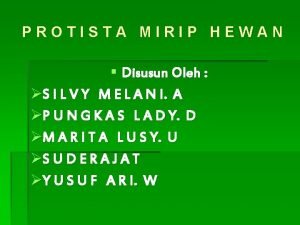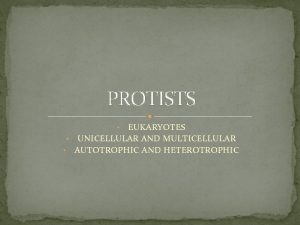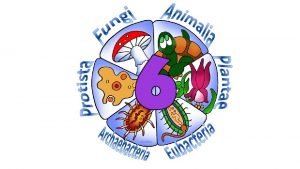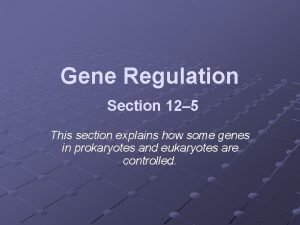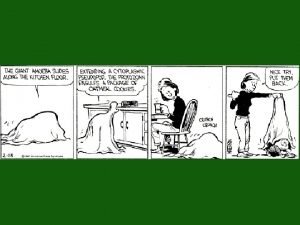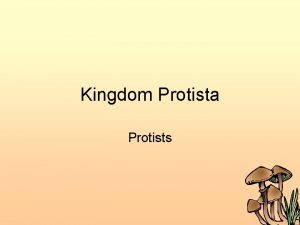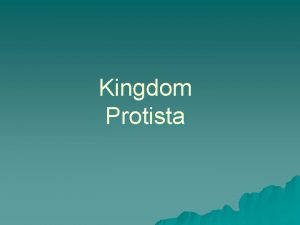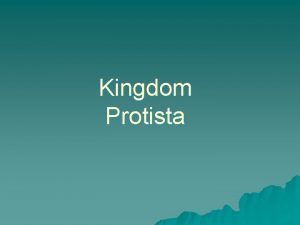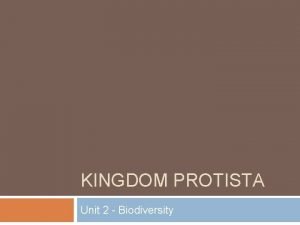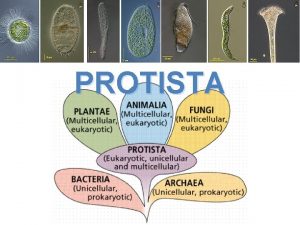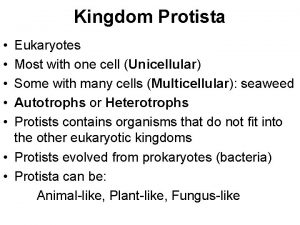Kingdom Protista The Unicellular Eukaryotes Protista Eukaryotic Usually









- Slides: 9

Kingdom: Protista The Unicellular Eukaryotes

Protista • Eukaryotic • Usually unicellular (One group of multicellular protista – the red, green and brown algae) • It is not a fungus, plant or animal • Video – The Protists - Biology

The Groups of Unicellular Protists Group Animal-like Protists (Protozoans) Fungus-like Protists Plant-like Protists Examples Amoebas, Ciliates, flagellates Slime Moulds, water moulds Eugleniods, diatoms and dinoflagellates Distinguishing characteristics • They consume other organisms for food. • Some species are parasites. • Heterotrophs • They absorb nutrients from other organisms, living or dead. • Some consume other organisms, some are parasites. • Saprotrophs (heterotrophs) • They can make their own food using photosynthesis. • Some consume other organisms when light is unavailable. • Some live as symbionts with other organisms. • Autotrophs (Heterotrophs)

Animal-like Protozoa Video – Flagella and Ciliated Protozoa

Animal –like Protists • Ciliates – these are covered in Cilia (short hairlike projections that coordinate together to assist with cell movement) • Some are free-moving ex. Paramecium and some are parasites (Balantidium coli – lives in the human gut and causes diarrhea). • Flagellates – have 1 or more Flagella (long whip like projection that propels the cell) • Some live in a mutualistic relationship with their host (Trichonympha – lives in the gut of termite and digests cellulose)

Fungus-like Protist – Slime mould Video – John Bonner’s Slime Mould

Fungus –like Protists • Special Heterotrophs – they absorb nutrients from living or dead organisms and from waste. (saprotrophs) • Three groups: – Plasmodial slime – tiny slug like organism that creep over damp decaying plant matter. – Cellular slime – individual cells that feed by eating bacteria. – Water mould – filimentous organisms that live on dead organic matter, or as a parasite on fish, insects and water plants.

Plant –like Protists - Diatoms Video – Plant Protists Biology

Plant-like Protists • Can carry out photosynthesis. • Most have chlorophyll – have a green colour. • Three groups: – Diatoms – (Phytoplankton) single celled- free floating aquatic organisms. Food for larger marine organisms. – Dinoflagellates – (Phytoplankton) single celled, has 2 flagella, can create red tide. (deadly toxic poison) – Euglenoids – Shallow fresh water, autotrophs in sunlight and heterotrophs in the dark.
 Prokaryotic protista
Prokaryotic protista Diatoms unicellular or multicellular
Diatoms unicellular or multicellular Phyrophyta
Phyrophyta Capital of egypt during the old kingdom
Capital of egypt during the old kingdom Old kingdom middle kingdom new kingdom
Old kingdom middle kingdom new kingdom Old kingdom middle kingdom new kingdom
Old kingdom middle kingdom new kingdom Youtube egypt
Youtube egypt Eukaryotic, unicellular, and autotrophic
Eukaryotic, unicellular, and autotrophic Prokaryote multicellular
Prokaryote multicellular Eukaryotic promoters are usually found just
Eukaryotic promoters are usually found just


